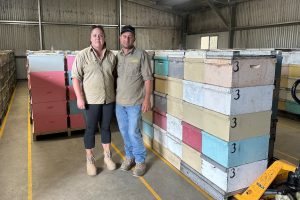Bee pest varroa mite common in New Zealand and the US where beekeepers have learned to live with it
/ By Lucas Forbes, Bronwyn Herbert, Emily Doak, and Tina Quinn

Beekeepers Denille Banham and Daniel Costa stand to lose all their hives due to varroa mite. (ABC News: Tina Quinn)
As authorities race to control the outbreak of varroa mite in Australia’s bee population, many beekeepers are saying it is time to learn to live with the mite.
Key points:
- A US bee health group is working on a “varroacide” to defeat the pest
- A New Zealand beekeeper says the worst effects of varroa mite were over in two years
- Beekeepers losing hives to euthanasia in Australia are calling for a policy shift from eradication to management
But what would that look like?
More than a year after varroa mite was first found at the Port of Newcastle, detections of the parasite have ramped up.
In recent weeks, thousands of beehives have been quarantined or euthanased after the mite was detected in hives in Kempsey on the NSW mid-north coast, many of which were delivered to parts of the Sunraysia and Riverina districts for almond pollination.
With Australia the only continent in the world where varroa has not taken hold, authorities have maintained a policy of eradication.
Varroa mites can destroy entire hives. (Supplied: Gilles San Martin)
For Kempsey beekeepers Denille Banham and Daniel Costa, the eradication strategy means their hives will be destroyed after varroa was found in some hives taken to Nericon, near Griffith, for the pollination season.
They have 750 hives in the eradication zones and 480 will have to be destroyed.
“Your 23 years of hard work, blood, sweat and tears, just all gone,” Mr Costa said.
Beekeepers are now calling for Australia to move towards managing the mite and living with it, instead of trying to eradicate it.
How is varroa mite managed?
The United States has been living with varroa mite since the late 1980s, when the pest was accidentally introduced to Florida.
The Honey Bee Health Coalition (HBHC) teaches beekeepers how to manage varroa mite and invests in research into developing pesticides that could kill the pest.
HBHC facilitator Matthew Mulica said varroa mite was so common in North America that if any hive did not have it now, it would within the next year.
That is why American beekeepers test for varroa two to four times a year.
If there are more than three mites per 100 bees, the coalition says beekeepers should start control measures immediately.
It is crucial to identify varroa to stop them spreading.
“If you do nothing, then in their last dying breath bees will fly off and infect other hives around you,” Mr Mulica said.
Regular testing carried out
One of the costs of management is hiring people to test hives and apply treatments.
Tumut beekeeper John Casey estimated his labour bill would double under a management policy, but said that would be preferable to staying with eradication.
“We’ve got 2,000 hives up at Euroley in the red zone. We don’t know if they’re going to let us move them or euthanase them,” he said.
“It’s a big loss of the bees and also the income we could make off them for the next couple of years.”
Hundreds of Belinda and John Casey’s hives have been impacted by measures aimed at controlling varroa mite. (ABC Rural: Emily Doak)
In the US, beekeepers can use chemical treatments to kill the mites, and there are some non-chemical techniques as well that interrupt the life cycle of the hive and slow varroa down.
Since varroa mite grows in the pupa of bees, producers can also remove the queen from the hive temporarily to reduce the number of pupa and cut down the opportunities for the mite to grow.
Mr Mulica said the HBHC was working with scientists in the US, Canada and Spain to create a “varroacide” to control the pest.
“We’re looking at all of these things and testing different compounds to find that next miracle molecule, if you will,” he said.
Varroa-resistant bees are also being developed which attack mites or kick infested bees out of the colony.
Silver linings in New Zealand
New Zealand beekeeper Barry Foster said the varroa mite outbreak in 2000 had put up to a third of beekeepers out of business, but there was a silver lining for those who remained.
Around the world varroa mites have killed off almost all the feral bees — the ones bred by beekeepers that escape into the wild.
Feral bees pollinate a lot of crops for free, but with fewer hives in the wild there is more demand for commercial pollination services, and that is what happened in New Zealand.
Mr Foster said beekeepers were paid more for their services and the industry recovered in just a couple of years.
“It was a fairly quick turnaround. Probably within a year or two we had gone through the most difficult learning and mental health period,” Mr Foster said.
He said the beekeeping industry had to adapt.
“You have to be a better beekeeper because of varroa and more on your game and better at planning,” he said.
We are here to share current happenings in the bee industry. Bee Culture gathers and shares articles published by outside sources. For more information about this specific article, please visit the original publish source: Bee pest varroa mite common in New Zealand and the US where beekeepers have learned to live with it – ABC News






